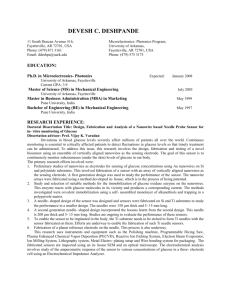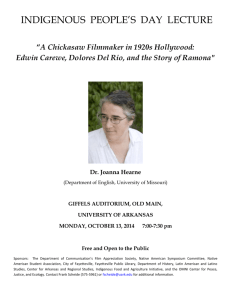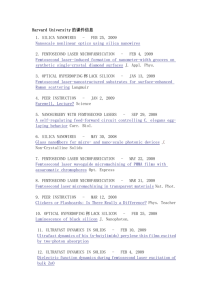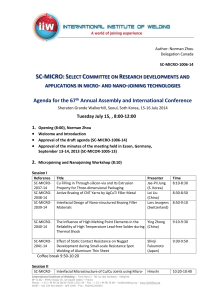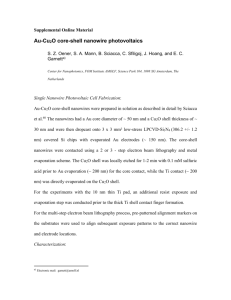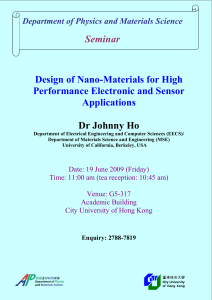Master of Science (MS) in Mechanical Engineering July 2003
advertisement
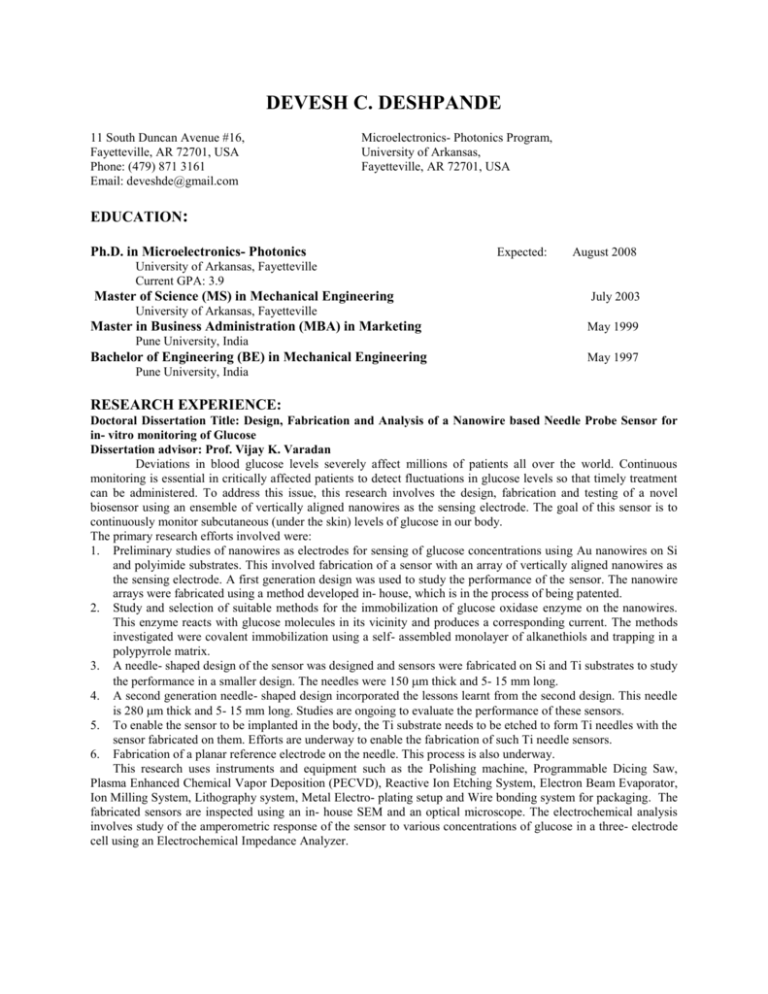
DEVESH C. DESHPANDE 11 South Duncan Avenue #16, Fayetteville, AR 72701, USA Phone: (479) 871 3161 Email: deveshde@gmail.com Microelectronics- Photonics Program, University of Arkansas, Fayetteville, AR 72701, USA EDUCATION: Ph.D. in Microelectronics- Photonics Expected: August 2008 University of Arkansas, Fayetteville Current GPA: 3.9 Master of Science (MS) in Mechanical Engineering July 2003 University of Arkansas, Fayetteville Master in Business Administration (MBA) in Marketing May 1999 Pune University, India Bachelor of Engineering (BE) in Mechanical Engineering May 1997 Pune University, India RESEARCH EXPERIENCE: Doctoral Dissertation Title: Design, Fabrication and Analysis of a Nanowire based Needle Probe Sensor for in- vitro monitoring of Glucose Dissertation advisor: Prof. Vijay K. Varadan Deviations in blood glucose levels severely affect millions of patients all over the world. Continuous monitoring is essential in critically affected patients to detect fluctuations in glucose levels so that timely treatment can be administered. To address this issue, this research involves the design, fabrication and testing of a novel biosensor using an ensemble of vertically aligned nanowires as the sensing electrode. The goal of this sensor is to continuously monitor subcutaneous (under the skin) levels of glucose in our body. The primary research efforts involved were: 1. Preliminary studies of nanowires as electrodes for sensing of glucose concentrations using Au nanowires on Si and polyimide substrates. This involved fabrication of a sensor with an array of vertically aligned nanowires as the sensing electrode. A first generation design was used to study the performance of the sensor. The nanowire arrays were fabricated using a method developed in- house, which is in the process of being patented. 2. Study and selection of suitable methods for the immobilization of glucose oxidase enzyme on the nanowires. This enzyme reacts with glucose molecules in its vicinity and produces a corresponding current. The methods investigated were covalent immobilization using a self- assembled monolayer of alkanethiols and trapping in a polypyrrole matrix. 3. A needle- shaped design of the sensor was designed and sensors were fabricated on Si and Ti substrates to study the performance in a smaller design. The needles were 150 m thick and 5- 15 mm long. 4. A second generation needle- shaped design incorporated the lessons learnt from the second design. This needle is 280 m thick and 5- 15 mm long. Studies are ongoing to evaluate the performance of these sensors. 5. To enable the sensor to be implanted in the body, the Ti substrate needs to be etched to form Ti needles with the sensor fabricated on them. Efforts are underway to enable the fabrication of such Ti needle sensors. 6. Fabrication of a planar reference electrode on the needle. This process is also underway. This research uses instruments and equipment such as the Polishing machine, Programmable Dicing Saw, Plasma Enhanced Chemical Vapor Deposition (PECVD), Reactive Ion Etching System, Electron Beam Evaporator, Ion Milling System, Lithography system, Metal Electro- plating setup and Wire bonding system for packaging. The fabricated sensors are inspected using an in- house SEM and an optical microscope. The electrochemical analysis involves study of the amperometric response of the sensor to various concentrations of glucose in a three- electrode cell using an Electrochemical Impedance Analyzer. Publications 1. FIB-TEM Characterization of Surface and Sub-surface Defects introduced into lithium niobate by a femtosecond laser, Microscopy and Microanalysis Vol 9, pp 876- 877, July 2003. 2. Nanoscale surface and subsurface defects induced in lithium niobate by a femtosecond laser, Applied Physics Letters Vol 83 no.21, pp 4420-4422 (November 2003) and the Virtual Journal of Ultrafast Science, December 2003. 3. Nano and Micro scale surface and sub-surface modifications induced in optical materials by femtosecond laser machining, Journal of Materials Processing Technology Vol 149 pp 585-590, March 2004. 4. Investigation of Femtosecond Laser-assisted Micromachining of Lithium Niobate, CIRP Annals Vol 53 no. 1, pp187-190, August 2004. 5. Investigation of femtosecond laser assisted nano and microscale modifications in lithium niobate, Journal of Applied Physics Vol 97 pp 074316-1 to 9 (April 2005) and the Virtual Journal of Ultrafast Science, April 2005. (first author). 6. Investigation of Nanoscale Electro Machining (nano-EM) in Dielectric Oil, CIRP Annals Vol 54 no. 1, pp 175178 August 2005. 7. Bio-inspired electric cilia development for biomedical applications: use of ionic electro-active polymer, nanowire arrays, and micro-stereo-lithography, Proceedings of the SPIE Vol. 6528, pp 652804 April 2007. 8. Development of Amperometric Glucose Sensors with Heterostructured Nanowire Arrays for Continuous Subcutaneous Monitoring, Proceedings of the SPIE Vol. 6528, pp 652819, April 2007. (first author). 9. Enzyme electrodes immobilized on hetero-structured metallic nanowire array for glucose sensing, Proceedings of the SPIE Vol. 6416, pp 641608, Dec 2007. 10. Aligned nanowire growth using lithography-assisted bonding of a polycarbonate template for neural probe electrodes, Nanotechnology Vol 19 no. 2, pp 025304, 16 January, 2008. 11. Development of a Nanoscale Heterostructured Glucose Sensor using Modified Microfabrication Processes, Journal of Micro/Nanolithography, MEMS, and MOEMS, accepted for publication (first author). 12. Two other journal papers in preparation. Major conference papers presented: 1. Presentation at the 14th International Symposium for Electromachining at University of Edinburgh, UK. on March 31, 2004 on Femtosecond laser machining. Masters research: Investigation of Enabling Technologies for Optical Microscope-on-a Chip. This research investigated the use of femtosecond laser pulses to write permanent memory in lithium niobate, an optical material by creating microscopic localized damage on its surface and sub- surface. This research was carried out in collaboration with researchers at the University of Nebraska and Lawrence Berkeley labs, and included on- site visits as well as long distance communication. The research efforts involved were: 1. The energy threshold for creating damage and the material removal rates of a femtosecond laser in lithium niobate was calculated using AFM. 2. The chemical modifications effected in lithium niobate due to the femtosecond laser were studied using Raman and Auger spectroscopy. 3. The micro and nanoscale modifications on the surface and sub- surface were investigated using selective area lift- off technique in the TEM and with Energy Dispersive Spectroscopy. 4. Propose a design for the Optical Microscope- on- a- Chip which would read out the memory written using the femtosecond laser. Fabrication of the microscope was not feasible due to time and resource constraints. TEACHING EXPERIENCE 1. 2. Teaching assistant for course Entrepreneurship of Technology in spring 2006. Course objectives included the study of the processes involved in the commercialization of an innovation, such as technology and market analysis, intellectual property assessment, production and marketing. Responsibilities included administering of online course website for dissemination of course materials, setting up of video conferencing facility for the benefit of off- campus students, assisting in grading, etc to 26 students. Teaching assistant for laboratory part of the course Laser Physics in spring 2006. Lab objectives involved experimenting with laser systems in conjunction with course. Responsibilities included setting up of various 3. laser experiments and teaching students about the concept and implementation and grading of lab reports to 6 students. Teaching assistant for the laboratory part of the course MEMS and Microsensors in fall 2006 and fall 2007. Lab objectives include fabrication and testing of a glucose sensor. Responsibilities include preparing samples, instructing students about the use of equipment and processes, instruction on theory associated with the processes, etc to 17 students in 2006 and 6 students in 2007. Mentoring Activities: 1. Mentoring of an undergraduate student as a part of the Research for Engineering Undergraduates (REU) program at the University of Arkansas in summer 2004. This resulted in a presentation at the end of the program. 2. Mentoring of undergraduate student in summer 2006 in the area of fabrication and analysis of biosensors. His research formed the initial studies of polypyrrole immobilization of glucose oxidase which ultimately led to a research paper that was presented at an SPIE conference in March 2007. 3. Mentoring of 5 students in research planning and implementation using the Microsoft Project software under the guidelines of the Microelectronics- Photonics program in fall 2006 and spring 2007. This effort is aimed at assisting students in effective planning of their graduate research activities and assisting them in avoiding common mistakes and deficiencies. One of the students won a $50 monthly award in research efficiency awarded by the program. RELEVANT COURSEWORK: During PhD: Intra/Entrepreneurship of Technology, Ethics, Proposal Writing, Semiconductor Devices, Advanced Engineering Economics, Nano manufacturing, Proposal Writing, Thin Film Processing lab. During MSME: Integrated Circuit Fabrication Technology and Lab courses, Electronic Packaging, Introduction to MEMS, Nanotechnology Devices, Laser Physics, Finite Element Analysis, Materials Laboratory. During BS: Engineering Mathematics, Applied Physics, Applied Chemistry, Applied Mechanics, Theory of Machines, Engineering Thermodynamics, Heat Transfer, Fluid Mechanics, Machine Design. TECHNICAL INSTRUMENTATION SKILLS: ANALYSIS: Scanning Tunneling Microscope, Atomic Force Microscope, Scanning Electron Microscope, Transmission Electron Microscope. ETCHING AND DEPOSITION: Electron Beam Evaporator, Ion Milling System, Plasma Enhanced Chemical Vapor Deposition, Reactive Ion Etching, Metal Sputtering system, Parylene coater. PACKAGING: Wire bonding ELECTROCHEMICAL ANALYSIS: Impedance Analyzer OTHERS: Polishing machine, Mask aligner/ Lithography system, Programmable Dicing Saw. COMPUTER SKILLS: OS and Word processing: MS Windows, MS office. Programming: Sun Java 1.2, HTML 4.0 Solid Modeling: Solidworks, AutoCAD, AutoDesk Inventor Finite Element Analysis: ANSYS Lithography Mask design software: L- Edit AWARDS and ACHIEVEMENTS: Rank 45/7000 in the Maharashtra State Entrance Test (CET) for MBA admission in 1997. National Merit Scholarship by Government of India (1991) for merit in the 10 th grade (SSC) state wide exam. OTHER ACTIVITIES: Active role in organizing a university level research paper and poster presentation conference at the University of Arkansas in 2001 and 2002. Active role in organizing cultural exhibitions and other activities for the “Friends of India”, a registered student organization at the University of Arkansas from 2001-2003. REFERENCES: Prof. Vijay K. Varadan Department of Electrical Engineering and Director, High Density Electronics Center, Twenty First Century Endowed Chair in Nano-and Bio-Technologies and Medicine; Prof of Neurosurgery, College of Medicine, UAMS; ENRC 1610, Engineering Research Center, University of Arkansas, Fayetteville, AR 72701 Phone: (479) 575-2873 Fax: (479) 575-6180 E-mail: vjvesm@uark.edu Prof. Hargsoon Yoon Research Assistant Professor, Department of Electrical Engineering ENRC 363A, Engineering Research Center, University of Arkansas, Fayetteville, AR 72701 Phone: (479) 575-6092 E-mail: hyoon@uark.edu Prof. Ken Vickers Director, Micro Electronics- Photonics Graduate Program PHYS 248, Department of Physics, University of Arkansas, Fayetteville, AR 72701 Phone: (479) 575-2875 E-mail: vickers@uark.edu Prof. Surendra Singh Professor and Department Chair, Department of Physics, PHYS 218, University of Arkansas, Fayetteville, AR 72701 Phone: 479-575-5930 Email: ssingh@uark.edu
